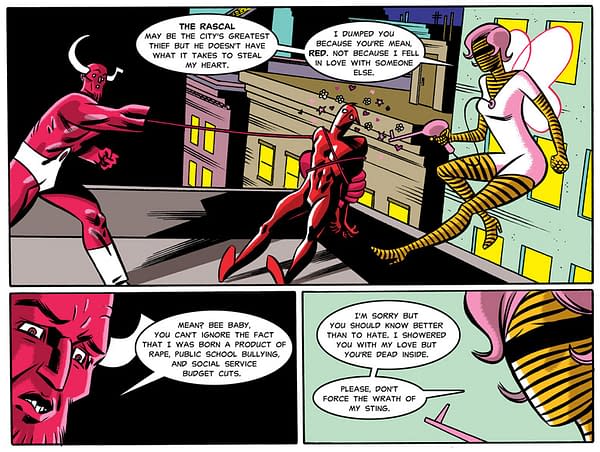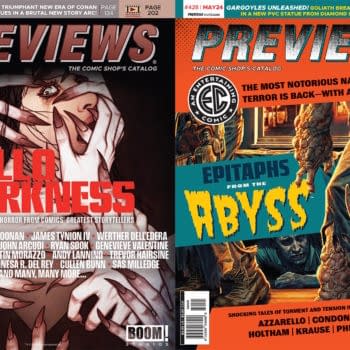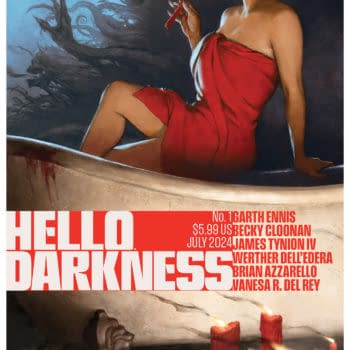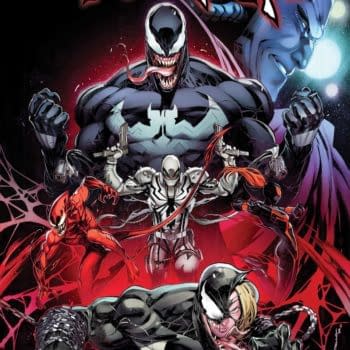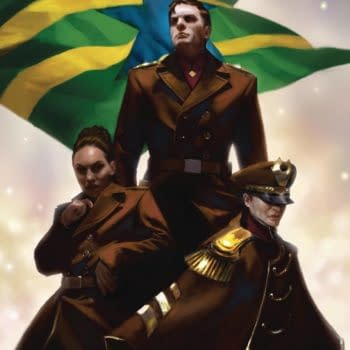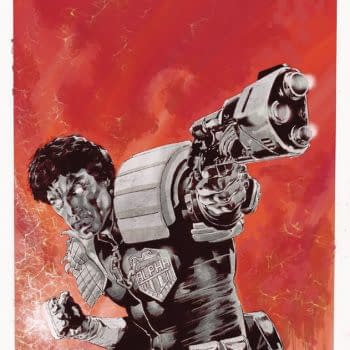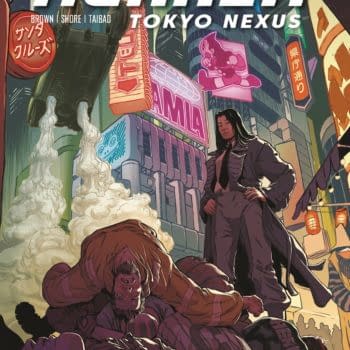Posted in: Comics | Tagged: Comics, dean haspiel, digital comics
Retro Rules In Haspiel's Red Hook

Dean Haspiel's been making the news lately with the announcement of his collaboration with Mark Waid on Archie Comics' Red Circle universe series THE FOX, but the Emmy Award-winning artist who worked on the HBO series Bored to Death has been leading the ranks of creator-owned projects for years. From founding ACTIVATEComix in 2006 to his newer multi-media arts salon TRIP CITY in 2011, Haspiel is curious, and experimental, when it comes to modes of bringing comics to the public. In that vein, he's recently released a short comic HOOKING THE RED HOOK, for free, on TRIP CITY, an origin story for a new kind of retro hero. Haspiel clarifies that this initial story is a teaser; he's hoping to crowd source funds or secure a publisher for a full series or graphic novel featuring the character in the future, rather than publishing it for free online, as he has done for many of his Eisner Award-nominated BILLY DOGMA comics, featuring a super bruiser avatar with existential angst.
RED HOOK is a creature of a different color, literally, the first comic Haspiel has self-created in a long while with a full, albeit purposefully "limited" color palette. This, he says, is part of the retro homage at the heart of the comic. The color range, from cerulean blue to blood red and buttercup yellow, goes hand in hand with the short story format, which he presents in a nod to the multi-story comics full of shorts featuring heroes in the Silver Age, one of his biggest influences despite his fluid navigation through indie autobio comics and mainstream superhero and adventure genres. He dubs RED HOOK "superhero pulp noir" and mentions his hero Jack Kirby when describing RED HOOK. You can certainly see Kirby at work in the bold poses and heroic angles in RED HOOK, but the twin influence of other pop culture media, like film and TV are there, too, like the Buster Keaton slapstick pursuit that kicks off the story.
This provides an opportunity for Haspiel to work with the costumed hero, at first known as The Rascal, and later Red Hook, in a variety of loping and acrobatic poses, which will strike a chord for Silver Age superhero comic fans. There's also the exaggerated but amusingly chosen sound effects from "Snap" to "Pok", sure signals that we're dealing with a hero tale. Bring in a perceived love triangle as the source of the menacing pursuit of a wayward thief by a serious thug on the rampage, and the relationship angle is even more Silver Age Marvel in tone. Another signature retro accent falls on the characterization of the femme fatale in question, a "super-hippie" who scatters "lust dust". The 60s abound in RED HOOK, but rendered with the charged energy and intelligent reflection of a comics creator reconsidering his own line of descent from Silver Age greats.
The humor in RED HOOK is intrinsic, built in and inextricable from the storyline. Like a good noir detective, The Rascal knows how to look out for his best interests and talk his way out of sticky situations, but like a modern reader critiquing the endless array of comic book villains from the Silver Age, Haspiel has his villain complain about the forces that have shaped his unfortunate career choice. He blames "rape…bullying…and social service budget cuts" for who he is. Haspiel's always been known for his powerfully witty pulp dialogue, blended with a variety of selected cultural references, and RED HOOK develops on that by being more choosy, spare in language, but punchy in those choices. The upbeat, screwball movement in the story does, however, take a darker turn, which brings us to underlying seriousness of RED HOOK.
One of Haspiel's favorite themes is love, and the tortuous perambulations relationships take before reaching often apocalyptic conclusions with massive fall out for those involved as well as innocent bystanders. As readers witness the simple but exacting conflict between a super villain and a femme fatale, Haspiel peppers the dialogue with heavy, resonant phrases with comic book world results that are bound to surprise. The Rascal, witnessing the wreckage of a relationship gone wrong is changed, too, and stripped of his light-hearted thief persona. That's what makes RED HOOK an origin story and what teases for even more surprising things to come if Haspiel gets a shot at developing this neat package of art, drama, and revised tradition further.
What he provides is a window on a world of comics that could be, a prototype tale of how we can address the best elements of comics tradition without slavish imitation or uninformed cynicism about its virtues. RED HOOK presents a singular type of vision, a schema for how color, layout, and stripped-down plots can still create something with the mythological status of an earlier era of comics. If anything, Haspiel goes back to the foundational elements of the Silver Age itself and seems to build upon the same structure rather than simply vaulting off the tropes of that heyday. But beware: Haspiel usually has some type of meaningful element in his works, something that speaks psychologically in archetypal ways about heroes and their lives. You'll find yourself re-reading the panels of this short web comic trying to decode exactly why it seems to pack such a punch so economically. It's also a little infuriating wondering what the graphic novel that Haspiel has scripted holds, and whether it'll ever appear in full iconically-hued glory. But what are you going to do, accuse Haspiel of being too appealing for free?
Check out RED HOOK. Maybe you'll be able to brag later that you're one of the ones who saw it first in its primordial origin story before the hipsters catch on and keep it on constant back-order.
Hannah Means-Shannon is a comics journalist and scholar working on books about Alan Moore and Neil Gaiman for Sequart.org. She is @HannahMenzies on Twitter and @hannahmenziesblog on WordPress.



